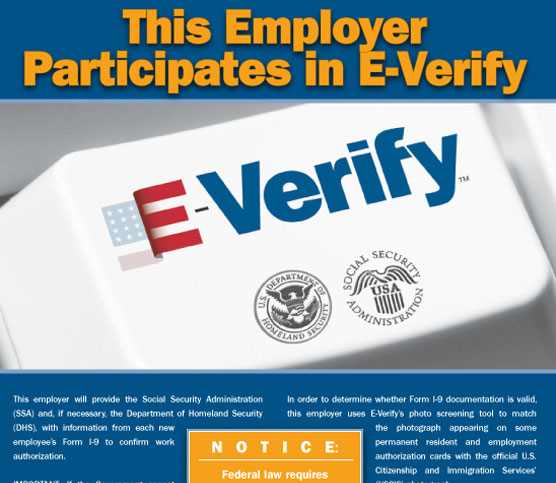Immigration Fight Simmered During Stimulus Negotiations
Immigration advocates may have won a battle in the stimulus package, but the federal program E-verify isn’t going away.
Jul 31, 20201.6K Shares186.2K Views
Among the many provisions of the $800–plus billion stimulus bill that were hotly debated and horse-traded behind closed doors, one that remained largely under the radar through the negotiations would have forced employers receiving stimulus money to use a controversial federal computer system to verify that all of its employees are legal U.S. workers. Although preliminary indications are that the requirement did not make it into the final version, the battle over E-Verify is far from over.
When it came to the stimulus bill, advocates on both sides of the issue fought hard behind the scenes. Many anti-illegal immigration groups favor the system, run jointly by the Department of Homeland Security and Social Security Administration. E-verify allows employers to electronically submit Social Security numbers for new hires and existing employees. If there is a match, the employee is considered eligible to work. If not, the employee and the employer have to go through various procedures to try to verify eligibility for employment. Supporters say that requiring all employers spending federal money to use the system is critical to ensuring that the stimulus creates jobs for legal U.S. workers, not for illegal immigrants. But immigrants’ rights groups have pushed back hard, saying that E-Verify is a cumbersome system riddled with flaws and based on inaccurate databases that can all too easily destroy legal U.S. workers’ ability to get or keep their jobs.
Illustration by: Matt Mahurin
“A lot of people look at E-verify as strictly an immigration enforcement tool,” said Michelle Waslin, Senior Policy Analyst at the Immigration Policy Center. “But what people don’t understand is that it would impact every single person who ever worked in the [United States]. Every single person who gets a job would have to be run through the system, which has a lot of errors. And employers don’t always use it correctly. So there could be very bad consequences for us citizens and legal workers.”
Supporters in the House, led by Rep. Jack Kingston, (R-Ga.), were able to pass an amendment requiring employers who receive stimulus money to use E-Verify in the House version of the bill. Although Sens. Jeff Sessions (R-Ala.) and Ben Nelson (D-Neb.) had said they would introduce it in the Senate, they never did.
“It is critical that the stimulus legislation include provisions to require the use of E-Verify when hiring workers to fill jobs created by the proposal,” Sessions and Nelson wrote in a letteron January 29 to Senate Majority Leader Reid and Minority Leader McConnell. “The inclusion of such a provision will be a key factor as we evaluate the merits of the stimulus package and gauge our support.”
Opponents of the system say the Social Security Administration has an error rate of more than 4 percent in its databases, which E-Verify relies on, translating to almost 18 million errors that could affect an employee’s work eligibility.
They also note that employers will have to register for the program, train their Human Resources staff to use it and require them to take an exam verifying they’re qualified. And so far the federally-administered program remains very small, with only about 100,000users.
“There are 7.4 million employers in the country,” Waslin said. “Is the system ready to take on this huge increase?”
But groups such as the Federation for Immigration Reform, which bills itself as seeking “to improve border security, to stop illegal immigration, and to promote immigration levels consistent with the national interest” vehemently advocated for including E-Verify in the stimulus bill. And yesterday, they said that even if E-Verify isn’t required by the stimulus bill, they’ll press for its inclusion in other legislation, or as a standalone bill.
“Both President Obama and [House Speaker] Nancy Pelosi said we should not let the perfect become the enemy of the effective and necessary,” said Ira Mehlman, a spokesman for the group. “We have millions of people in this country working illegally. Far more people will lose their jobs due to illegal aliens than could lose it due to an error in the system.”
Mehlman cites a statistic provided by the Department of Homeland Security that says that “approximately 96.1 percent of qualified employees are cleared automatically by E-Verify, and 99.6 percent of all work-authorized employees are verified without receiving a tentative nonconfirmation or having to take any type of corrective action.”
In other words, Mehlman said, “the vast majority of the discrepancies that are flagged by E-Verify are rectified within 24 to 72 hours and are most often associated with things like name changes as a result of marriage.”
But the anecdotal evidence suggests more serious problems. At a Congressional hearing in 2007, for example, Rep. Zoe Lofgren (D-Calif.), chairman of the Immigration Subcommittee, told the story of her own legislative counsel, Traci Hong. When a government agency used E-verify, Hong showed up as ineligible to work in the United States. Hong had to make “six separate trips” to the personnel office and to the Social Security Administration, according to Lofgren, to prove that she was a naturalized U.S. citizen. “Others might have given up,” Lofgren told USA Today.
And a study conducted by Westat, a consultant to the Department of Homeland Security, although finding overall employer satisfaction with the program, received a long list of complaints from employers it surveyed. These included that an applicant “with a good authorization card does not initially pass,” the system “doesn’t have current information,” the computer “shows nonconfirmation” even after the employee has gone to the Social Security agency and been told they’d cleared up the problem. Employers cited problems particularly “for new employees on a specific visa type, refugees and employees who have obtained US citizenship.”
In fact, the study found that the error rate for foreign-born U.S. citizens was almost 10 percent, and that employers often terminated or didn’t hire people whose information was initially unconfirmed, rather than allow the employee or applicant to try to fix the problem.
“You’re talking about a significant number of people and a system that doesn’t have provisions in place to allow them to fix their data,” said Caroline Fredrickson, director of the ACLU’s legislative office, which worked with a coalition of immigration rights groups to oppose the inclusion of E-verify in the stimulus bill. “There’s no appeals process. With an organization like the SSA that’s already dealing with huge backlogs from people not getting disability payments; this is the last thing we need.”
“The stimulus bill designed to put money into the economy quickly and efficiently. Instead, they’re requiring that money pass through a broken-down bureaucracy that hasn’t worked in a pilot program,” Fredrickson said.
Although the E-verify requirement appears to be popular among many Republicans and some Democrats in the House, not surprisingly, it has strong opponents in the business community. Both the U.S. Chamber of Commerce and the editorial page of the Wall Street Journalhave weighed in against it.
On Monday, the Journal’s editorial board notedthat although President Bush had issued an executive order that would have required all federal contractors to use E-Verify starting next month, Homeland Security Secretary Napolitano has delayed its implementation until May 21, “to see what needs to be done to increase the capacity for the E-Verify system.”
The Journal wrote: “If the Obama Administration is concerned that the program will buckle under the demands of 168,000 or so federal contractors, E-Verify certainly doesn’t belong in a stimulus package that would require the system to determine the job eligibility of tens of millions of new hires.”
The Journal also noted that the E-Verify system is vulnerable to identify fraud, since a job applicant using someone else’s social security number (and a fake card) would not be detected by the system.
As governor of Arizona, Napolitano signed into law the Arizona Legal Workers Act, which was passed by the Republican-controlled state legislature and requires all employers in the state to use E-Verify beginning Jan. 1, 2008. However, The Arizona Republic reportsthat by the end of September, only about 22,000 of the approximately 150,000 employers in the state had signed up to use the system.
“Many people still see this as a magic bullet,” said Waslin. “There’s this sense that we must be very tough on immigration. We understand that our immigration system is broken and we need to fix it. But the way to do that is to have a real constructive rational conversation about fixing the immigration system. Not a proxy fight on every bill.”
“If you look at the restrictionists, they’ll blame immigrants for everything from the economy to global warming,” continued Waslin. “We need to have a more constructive conversation.”

Hajra Shannon
Reviewer
Latest Articles
Popular Articles

